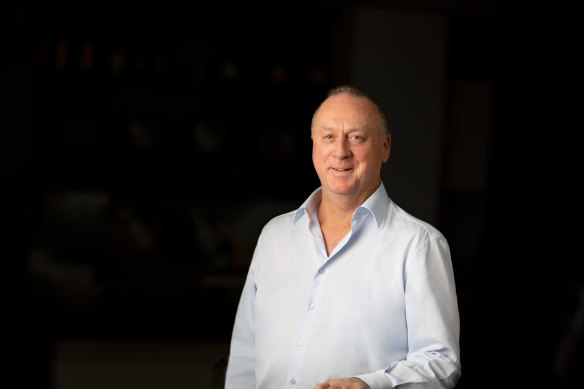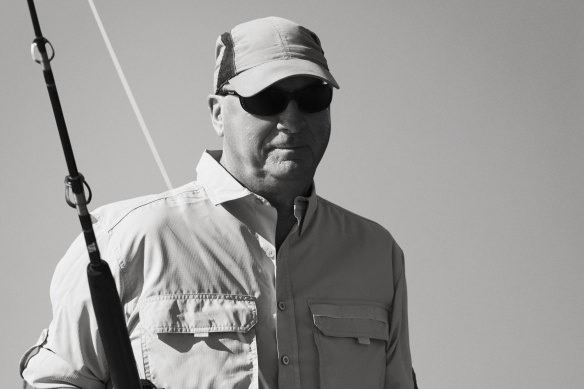By Peter Milne
Thirty years ago Chris Ellison started a business to lay pipelines. He now runs the 25th most valuable company on the ASX and talks to global car manufacturers about helping quench their growing thirst for batteries.
The Mineral Resources managing director had a good story to tell his annual general meeting last week. Surging demand for its newest product lithium sent its share price up almost 50 per cent this year, and Ellison thinks supply will take some time to catch up with rising demand.

Chris Ellison managed engineer Monadelphous out of receivership before starting Mineral Resources.
“From finding dirt to having a (lithium) hydroxide plant running, it’s about six or seven years,” he said.
“If we’ve got seven years in the sun, we’re gonna have a lot of fun.”
MinRes mines for spodumene, a rock containing lithium, from Mt Marion in WA’s Goldfields and at Wodgina in the Pilbara.
Only a year ago Ellison’s company and its partner - US lithium giant Albemarle - decided to bring Wodgina out of two years of care and maintenance due to poor prices.
Ellison said the two mines produce about 29 per cent of the world’s spodumene.
His focus now is convincing Albemarle to build a plant to make lithium hydroxide from Wodgina spodumene in the Pilbara, not China, despite it potentially costing twice as much. Ellison is convinced customers will pay a premium for product made where there are fewer concerns about how the workforce and environment are treated.
MinRes was a mining services provider until it started producing iron ore 12 years ago and despite the lure of lithium, Ellison is not giving up on the steel-making ingredient.
“If you have a look back at the last 40 to 50 years, it’s the foundation commodity that’s created the top three or four mining companies on the planet,” he said.
“It’s a cash generator, once you got it operating it’s relatively simple, there’s not a lot of technology being an iron ore miner.”
Exporting iron ore also made the fortunes of Australia’s two richest people: Hancock Prospecting’s Gina Rinehart and Fortescue’s Andrew Forrest.
After finding the deposit, the key to Pilbara iron ore wealth is rail and port capacity and the majors - BHP and Rio Tinto - are not for sharing. Forrest built his own railway after fighting in the courts for years to access existing track and Rinehart’s 70 per cent-owned Roy Hill followed, laying the Pilbara’s fourth private rail network.
In February the WA government released the last available capacity at Port Hedland, including a berth for new entrants.
“We got the majority of that, Hancock got a minority share in it, we used that as currency,” Ellison said. In return for an equal share of berth capacity MinRes gained access to Roy Hill’s railway that will supplant its expensive trucking of ore to the coast.
A five-hour drive to the east MinRes does have to build its own infrastructure for its new Onslow Iron project, but is doing it as cheaply as possible. Driverless road trains will travel a 150km private haul road to Onslow to load small “transhippers” that will ferry the ore out to waiting bulk carriers, avoiding the need to dredge an expensive shipping channel.
A possible glitch in the plan is that the haul road runs through Minderoo station, the childhood home of Forrest, who has gone to court more than once to, ironically, keep it free of mining activity.
“I don’t perceive any problems there,” Ellison said, perhaps in hope.
MinRes’ next venture - gas production - was prompted by Ellison’s desire to secure energy for his mines and lithium refineries.
There was early success with the Lockyer Deep-1 well, drilled a year ago in the Perth Basin about 230km north of the capital, and the likelihood is MinRes will have much more gas than its needs.
“Have you ever got enough of anything, has a girl got enough handbags?”
Mineral Resources ceo Chris Ellison won’t rule out securing more Perth Basin gas with M and A.
Ellison said he is not considering supplying an LNG plant that requires an exemption from the McGowan government’s ban on the export of onshore gas.
In 2020 the WA Premier controversially gave the nearby Waitsia field, that Kerry Stokes, chair of the state’s dominant media company SevenWest has a large stake in through Beach Energy, permission to export its first five years of production.
“I don’t want to stir that pot,” Ellison said.
Instead Ellison is looking at the energy-intensive process of processing low-grade magnetite iron ore and using gas to make ammonia and urea.
“It’s way, way cleaner than burning coal, it’s an awful lot cleaner than burning diesel,” he said.
Ellison’s advocacy for gas places him between the two other much richer WA iron billionaires worth more than $30 billion compared to his $1.8 billion stake in MinRes.
He was speaking the same day climate change sceptic and prospective coal miner Rinehart was sitting at Donald Trump’s launch of a run at the US presidency, a prospect he greeted with “God help us.”
However, his plans to produce gas for decades would be heresy for Forrest who aims for Fortescue to have net zero emissions in eight years and at the COP 27 climate conference last week said there was no excuse for companies to not move beyond fossil fuels.
The highly prospective Perth Basin was home to a flurry of mergers and acquisitions activity in November. Strike Energy’s bid for its joint venture partner Warrego was gazumped by an all-cash offer from Beach Energy, and many are expecting more action.
“We’ve got our eyes on it,” Ellison said, despite the success of Lockyer Deep.
“I’d be lying if I said I wasn’t interested.”
“Have you ever got enough of anything? Has a girl got enough handbags?”
Ellison’s analogy may have been inspired by his highest profile hire in 2022, former foreign minister Julie Bishop, as a strategic adviser.

Mineral Resources ceo Chris Ellison was “the fisherman” in a company campaign to promote the individuality of its workforce.Credit: Mineral Resources
Her first outing was more tactical than strategic, starring in a camp comedy video introducing MinRes workers to their luxurious new headquarters in Perth’s downmarket Osborne Park, best known for car yards and furniture stores.
The gym, mental health support, medical suite and restaurant serving $8 take-home dinners sets MinRes up well in the fiercely competitive - for employers - WA labour market.
Better accommodation is the carrot for many of MinRes’ nearly 5000 employees that fly-in and fly-out.
“The standard donga on site, it’s a little bit like a prison, it’s got a little square window, and it’s a bit of a s--thole,” he said.
Ellison’s alternative is a three-times bigger “resort style” room with a queen-size bed at four times the cost, and the first batch of 1000 have been ordered.
Change has already happened at the top of the company with four of Ellison’s six direct reports starting at MinRes in the past four years.
The focus on people produced a tome-like annual report festooned with pictures of employees and their out-of-work pursuits, ranging from Ellison the fisherman, an electrician gamer and an IT bonsai artist.
After the AGM Macquarie called MinRes its preferred company in the broader resource sector, with buoyant lithium prices now and organic growth options longer term.
But closing his AGM speech Ellison was not in sales mode: “So that’s sort of a round up on our business, sorry if I bored the hell out of you for a while.”